I had to regrind the knife blades for a
concealed tang to epoxy into the bone handles. The knives below were
given to Bill, Jr., when Bill and Nichole visited with us on July 7th and
8th, 2016.
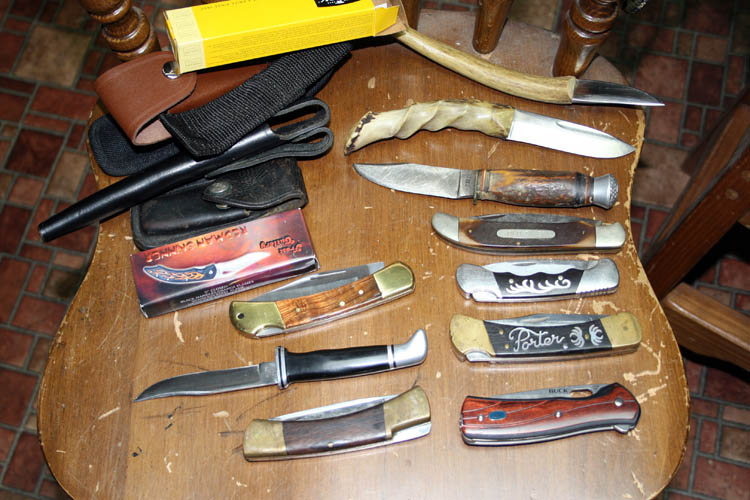
The third knife from the top on the right belonged to my Father-in-Law,
Henry Adcock and my bride purchased it from the Adcock family auction after
the passing of her Dad. Henry used that knife for skinning catfish and at
one time there was a scabbard for it. The two top knives on the right were
fabricated from a Buck seven (7) inch length Bowie knife that I cut into two
pieces and fashioned the handles on them from deer antlers. The fourth
knife from the top right is an Old Timer that I reshaped the tip into a drop
point and Bill field dressed the
first doe he ever harvested with it.
I inlaid and cut finger grooves on a
Buck Duke lock back folding hunter
knife model 500, fifth knife from the top on the right and inlaid mother of
pearl into both sides of the knife.
The Buck lock back blade knife below it was inlaid for my Dad and Mom
gave it to me when Pop died in August 2007.....I sure do miss him!
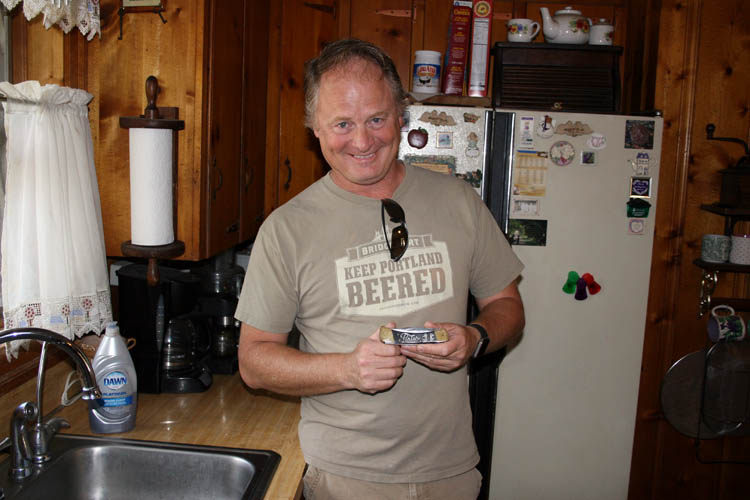
Bill, Jr. with the Porter inlaid Buck folding hunter lock back knife.
Below, a couple close-up pixs of both sides of the inlaid mother of pearl
knife. Pop was really proud of that knife and I got great satisfaction
doing the inlays for him.
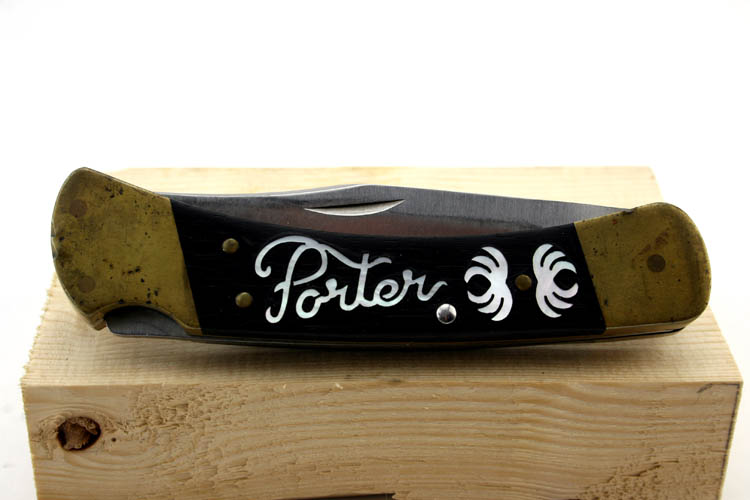
There is a good patina on the brass since this knife is well over forty
(40) years old. Back in the middle 1970s when I was doing custom musical
instrument inlays on a daily basis, "Porter was
considered the source for accurate pre-war reproduction inlays"
to quote David Nichols of
Custom Pearl Inlay. I think he said
that with a little pun intended, because he certainly is a Master at cutting
and inlaying various inlays and that phrase was used in my 1970s
advertisements......grin
if you must!
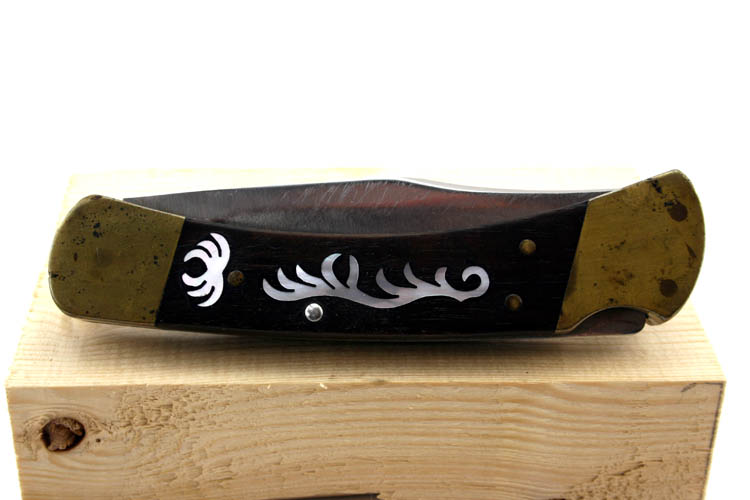
Bill, Jr. was given a special knife I inlaid back in the mid 1970s.
Information archived from my
Biography blog and a copy and paste below. Click on thumbnail
pixs for a larger screen view:

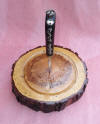
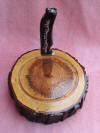

Above pixs of a custom inlaid Smith and
Wesson skinning knife that I did for myself around 1975. I retired that
knife to my show case in the early 1990s. The mother of pearl inlays are
from a copyrighted pattern of mine titled
“Flaming Claw”
and my standard pattern I used on banjos and Dobro aka resophonic guitars.
The inlay work on the knife handle was all free-hand if I remember correctly
due to the curvatures of the handle on all sides.
Bill sent me a pix of the knives on 07-14-16 and plans
to get a more permanent display case for them.
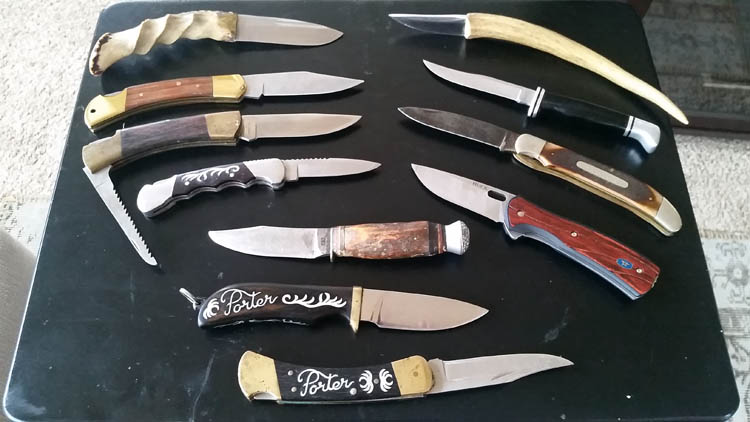
I told Bill, Jr., that I hope this was not a premonition of myself
kicking out anytime soon, but felt like he would give those knives a good
home and some of them has special meaning. On the other hand, we are not
promised tomorrow either and time waits for no one!
"Live today, the best that you can."
VICTORINOX SWISS ARMY RED TINKER KNIFE
Around 10 or 15 years ago, I purchased a
Victorinox Swiss Army Red Tinker
knife, of which I recently misplaced it and have looked high and low for it
without success. If I did lose the knife, it was probably in
Albemarle, NC at one of Medical facilities. During the past seventeen
years of employment with the NC Department of Correction, we were not
allowed to have a personal knife on our person which is understandable in a
correctional environment, However, since retiring in 2012, I have
gotten back into the habit of keeping a small knife in my pants pockets
which comes in handy at times.
Below is a screen capture of the Victorinox Swiss Army Red Tinker model
knife:
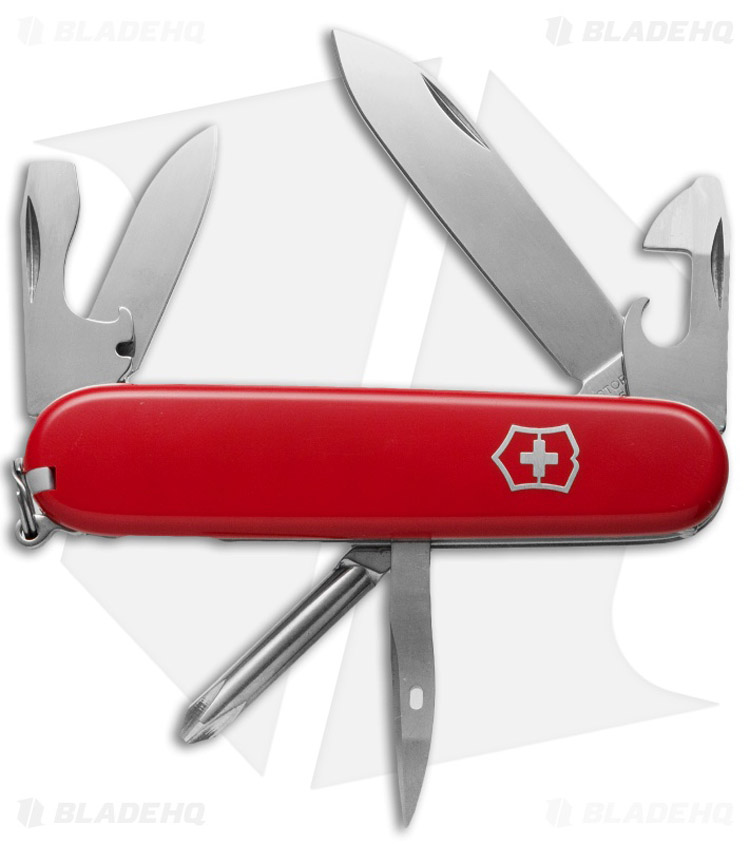
That knife was used frequently during the past five years and hope I can
locate it. In the meantime, I ordered a replacement knife; cost only
18 bucks including shipping and it
should arrive from California tomorrow, whereby I will be one happy camper again.
It is a production knife but keeps a good edge and easy to sharpen.
The various tools on the knife come in handy at times.
LOST AND FOUND
While putting on a pair of dress slacks on March 19, 2017, I found the
missing Victorinox pocket knife in the right pants pocket. If memory
is correct, I felt several pairs of dress slacks that I had recently worn
prior to the knife missing, but I didn't do a thorough "shakedown."
Now, I have a spare......grin if you must!
KITCHEN KNIVES USED
Like my hunting knives, we have used many various brands of Kitchen
knives over the years....some being literally junk and a few others doing
the job they were intended to do. We have never owned a high dollar
set of kitchen knives.
You can easily spend 1K to 2K for a set of very good kitchen knives and
by no means the most expensive. For 175 bucks +- you can get an excellent
10 inch Chef knife manufactured by Henckels, Wusthof, Messermeister, Shun,
Global and/or Mac, but the inexpensive 10 inch Case Chefs knife
will perform fine. The same goes for the 300 to 500 dollar Randall Made
hunting knife; a 50 dollar factory stock hunting knife will do just as good
and sometimes better; been there, done that. It is all about what you
want, what you can afford and whether or not you want to impress someone.
If that is your thing, go for it! There is nothing wrong with
purchasing the best, if you can afford it!
The worst knives, I believe were manufactured by Wilkerson Sword and
Farberware of which were a set of knives and don't remember how many were in
those sets; but again, they left a lot to be desired. They would not
hold an edge or was about impossible to get a razor sharp edge on them.
Factories have the ability to polish a razor sharp edge on them, but is very
difficult to get in the same edge in a home environment. I have one
curved boning knife made by Forstner which was bought out by Victorinox and
keeps a razor edge very well too.
Over the years, my bride and myself have had excellent success with
kitchen knives made by
Case and some of them are probably forty (40) years
old and still going strong today. They hold an edge fairly well and
not difficult to get a razor edge on most of them.
My favorite paring knife is made by Victorinox and it will maintain a
razor edge and again, easy to sharpen. All through my
Recipe pages,
you will find the
knives mentioned above in usage, with the
paring knife and the 10 inch length Chefs knife used the most.
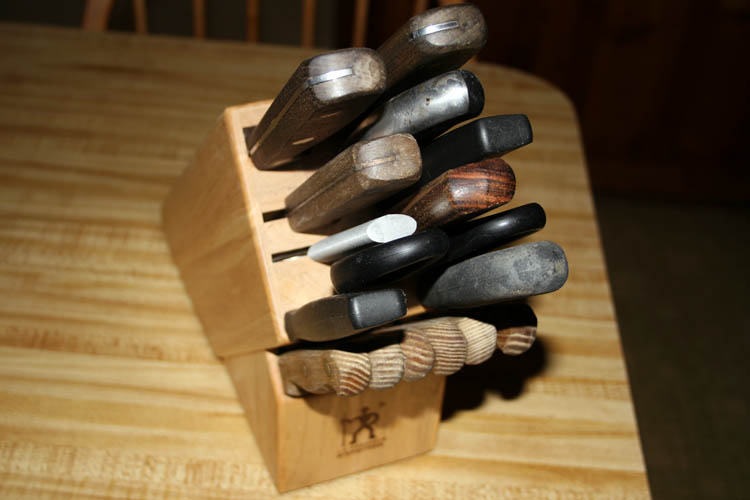
FUR SKINNING KNIFE
Back in the early 1980s when I was fur trapping, I had a couple knives
used exclusively for skinning fur bearing animals, but they were lost and/or
misplaced. Below is a screen capture off the internet of one that I
used and it worked excellent for skinning raccoons, etc. It is
currently misplaced somewhere.
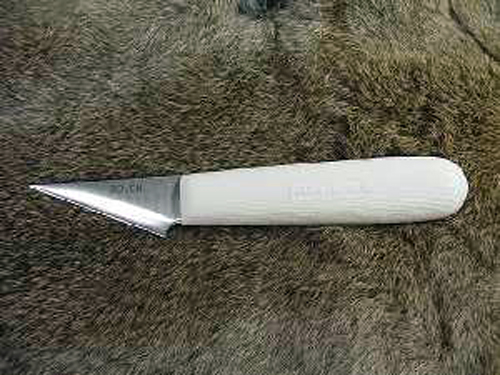
I found the missing skinning knife on October 28, 2017 while getting a
cooler out for the Church of God
Fall Festival.
RECENT KNIFE MODIFICATION
Now we are getting to what started this entire "short" story. I did
not do a photo essay of how I did the modification to the Victorinox Rabbit
Knife, but will more or less describe what I did.
Below is pix of a Victorinox Rabbit Knife with a 4 inch length blade:

The Rabbit knife has a stiff flat ground stainless steel blade and
sharp as a razor. I was debating on whether or not to make the
modification, since I didn't know how far the concealed knife tang extended
into the molded Fibrox handle.
Quite a number of years ago,
Robert Hough of
Carolina
Antiques & Restoration in Ellerbe,
NC gave me a walking staff which had a four point deer antler screwed into
the handle of the walking staff. The walking staff was heavy enough
for Goliath to use as a walking stick or implement of war and never did use
it as intended. I removed the deer antler a few years ago and he had
the screw glued in place with epoxy in the base of the antler and I broke
the screw off trying to remove it from the deer antler. Sometime
later, I ground and drilled the screw down where I could use some type of
medallion to cover up the unsightly screw. I cut the antler length to fit the
width of my hand and it sit around on my work bench for about a year before
getting around to it. I finally drilled a 3/8 inch hole in the end
where the tang of a knife blade would go.
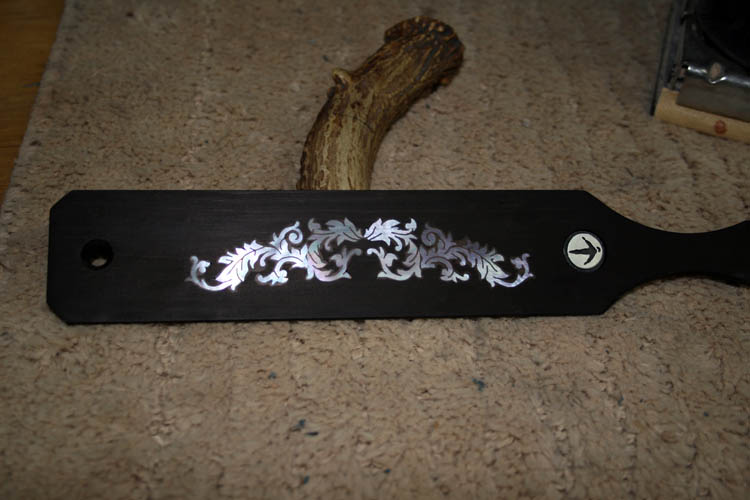
Above pix of the deer antler handle being used to prop up a custom turkey
box call lid to photograph.
I drilled a few holes in the Victorinox Rabbit Fibrox knife to ascertain the
length and width of the tang which was at least two inches in length.
I used my band saw to remove the Fibrox handle from the knife tang. I
had a good amount of grinding to do to the tang as it was much larger than my 3/8
inch diameter hole and was irregular in shape, since I needed basically a
rectangular shape. I used masking tape; several layers on the knife
blade for safety reasons while grinding the tang to shape. I had a glass of water close by the grinder to keep
the knife blade cool while grinding to prevent changing the hardness aka
temper of the blade; not desiring to make it harder or softer. It didn't
take too long to get the tang reground using a 6 inch diameter coarse
grinding wheel and also a fine grit 6 inch diameter grinding wheel and finished up on the 1 inch width x
42 inch length aluminum oxide sanding belt. A Dremel tool and a small
grinding disc was used to square the tang of the knife to the blade since I
planned to use a brass hilt or guard more or less just for decoration.
It would not offer any protection to keep your hand from slipping onto the
blade if you went crazy with the knife......grin if you must! I
purposely did not make a hilt with a finger guard since I wanted to be able
to insert the entire knife blade and a portion of the handle beside a deer's
rectum to detach it from the pelvic bone to allow the anus/rectum to be
pulled through the pelvic bone when field dressing a deer. Four and
one half inches to five is basically what is required for a blade length to
field dress a large Whitetail Deer. Of course the small deer that I
mostly harvest, it will not be a problem....grin if you must!
After getting the tang ground to shape, I then found a small piece of
flat sheet brass that was approx. .062 inches in thickness that was left
over from a stamping operation that I did on my banjo tube and
plate flange
sometime in the mid 1970s. The piece of brass was removed from the
brass flange circle to allow the banjo neck to fit onto the wood rim
assembly for you non banjo folks. I believe that particular piece of
brass was the initial test sample that the tool and die maker sent me after
they manufactured the die set for my approval.
I traced the outline off the end of the antler which had the hole in the
end and marked a couple reference lines and drilled three 7/64 inch diameter
holes using my drill press into the flat brass to accept the reground tang. I then, wallowed out the length of the
holes with the drill bit in a portable hand drill and used a small rectangular needle die makers type file to finish the rectangular
opening to allow the tang to fit into it. The purpose of the brass
hilt would be to cover up the 3/8 inch diameter hole that was drilled into
the antler for the knife tang to fit into using epoxy to secure the brass
hilt to the knife tang and to secure the tang to the antler handle. I
used a pair of hand held
Weiss M6R cutters to trim off excess material from the
brass hilt. The ideal method to attach the hilt to the knife blade is
using low melting point solder, of which I didn't have any on hand.
In order to make certain the knife tang would be very secure inside the
antler, I ground lines into the edges of the tang where the epoxy glue would
adhere to using a Dremel tool and carbide fluted end mill. I also ground/drilled small holes into the wall of the inside 3/8 inch
diameter hole in the antler for the same purpose.
After everything was dry fitted, I used 5 minute epoxy to glue the
hilt and knife tang to the antler handle and also the pewter turkey track
medallion. I allowed the epoxy to set up several hours and ground the brass
hilt to match the antler handle taper connection using the 1 x 42 inch aluminum
oxide sanding belt.
Below, a few pixs of the completed knife:
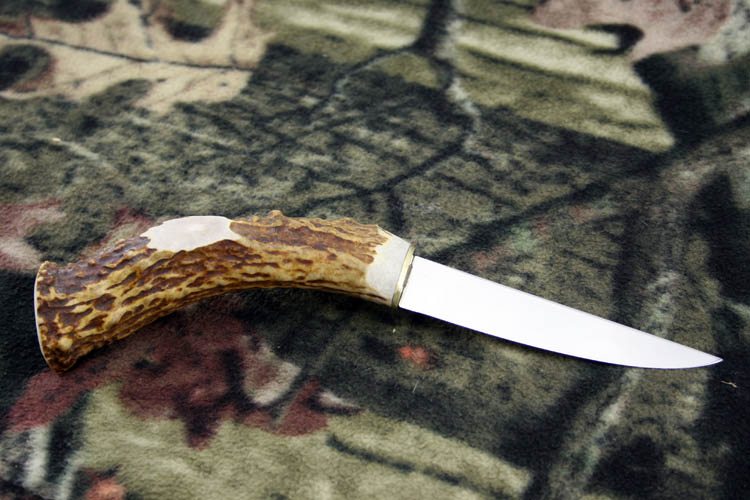
This knife will definitely make a good general purpose usage knife for
sure.
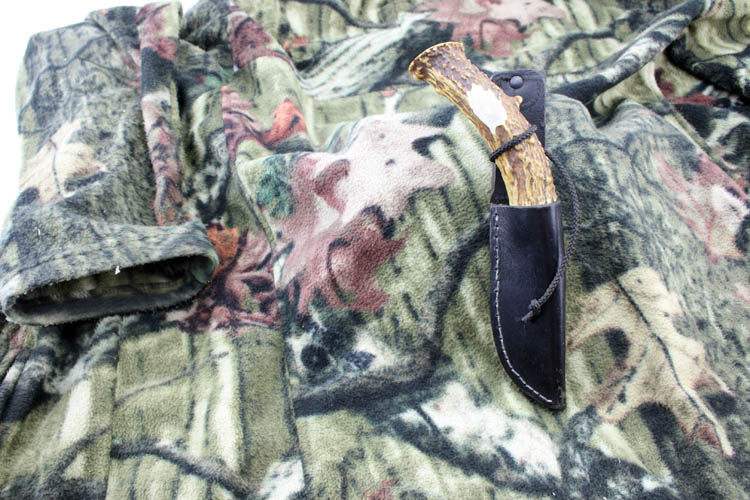
The pewter turkey track medallion hid the broken screw shaft real well.
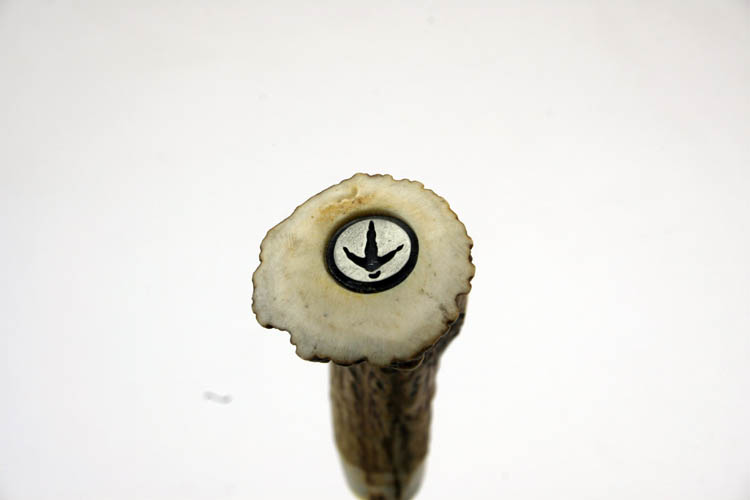
Below pix taken with the upper soft light box operating properly.
Makes a difference too!
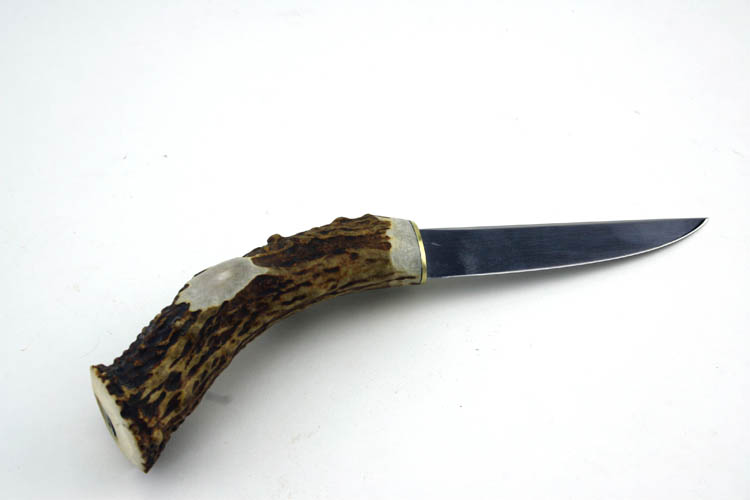

My white back drop paper definitely needs changing, since it is badly
soiled. I like the handle drop of the knife instead of just a straight
handle. This knife would serve well for the traditional muzzleloader
hunter as a
patch knife too or a trappers knife. I can envision this
knife in a sheath hanging from a Mountain man's neck or belt back in the middle
1800s while trapping beaver for the European fur trade.
As stated earlier, this was an impromptu project, therefore didn't really
do any serious planning for taking pixs, etc. It was a rainy day and
needed to have a fun project to do and this one was it. There has been
many more knifes over the years, but these are the ones I could remember and
find pixs of them. I have several utility knifes that I had left over
from my musical instrument repair days and a few of them are still going
strong. I will get a pix of them just for ole times sake!
UTILITY KNIVES CURRENTLY IN USE
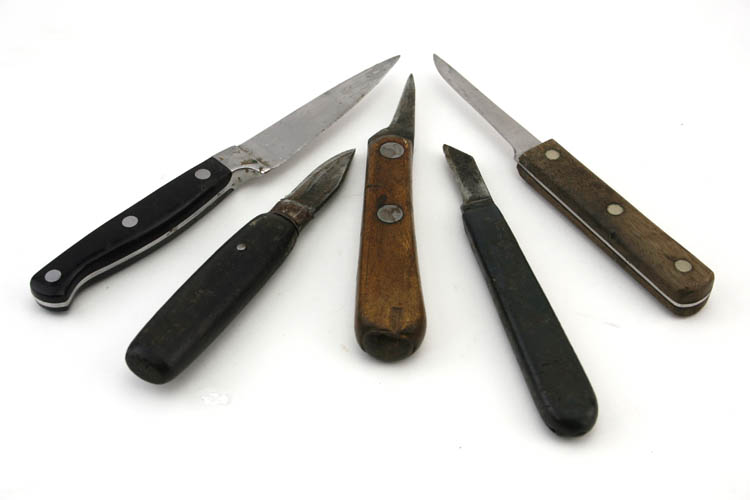
Also, my earlier pixs I took of the custom handle Victornox knife didn't come out very well. I later
found out that my upper soft light box had no power to the light fixture
head and was due to a loose power cord connection and was corrected.
Seems like, Murphy's Law
never sleeps. The above utility knives get used pretty regular in my
shop and/or archery corner of my basement "Man Cave."
KNIFE PHOTO SHOOT OUTSIDE
I took the knife and scabbard outside and used a large milky quartz rock
in our upper yard for my back drop and the following pixs posted:
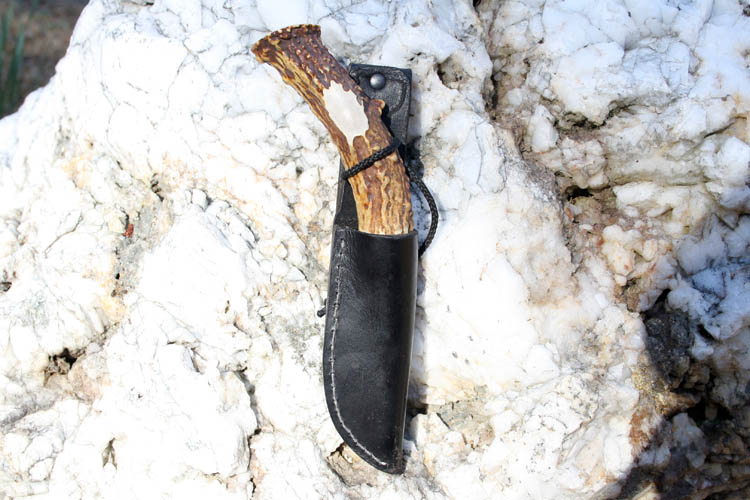
The below pix shows the turkey track medallion which adds a touch of
customizing to the handle. The inlaid turkey track medallion was
mainly used to cover up the broken off screw that was glued into the deer
antler which was attached to a walking stick.
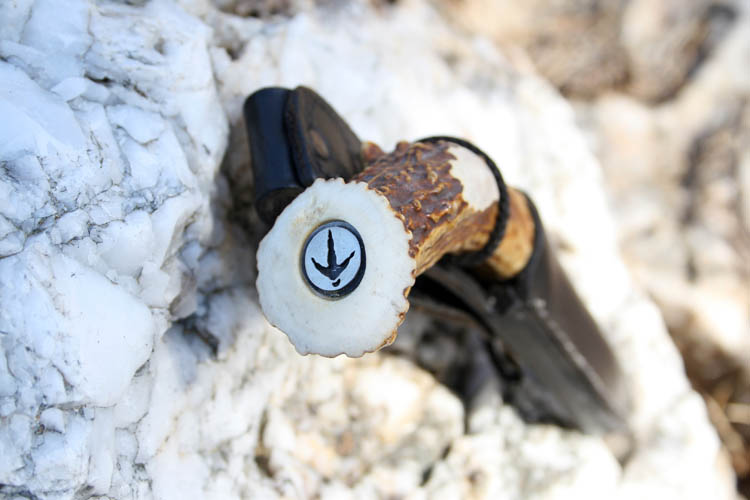
I used a piece of black nylon braided cord to make a safety tie down for
the knife scabbard since there is no finger guard on the brass knife hilt. The knife
will not slip out of the case with the safety cord pulled tight due to
tension created by the cord going into and out of the scabbard. I
might inlay a piece of oval brass into the white area on the side of the
handle where the deer antler brow tine was removed. The knife scabbard
was made (cut down to size) from the original scabbard for the Buck Hunter 7
inch length blade knife of 1968 mentioned in this short story. I used
a hand sewing awl, small drill bit and glued and stitched the holster together
using a simple stitch. This was done back in the mid 1980s and made
originally for the Buck blade cut down blade with the spiral finger grooves
ground into the handle. That knife was given to one of my friends, C.
W. McKenzie of Robertdale community adjacent Rockingham, NC and later
traded him a set of Boker Tree Brand railroad commemorative pocket knife set
for the knife.
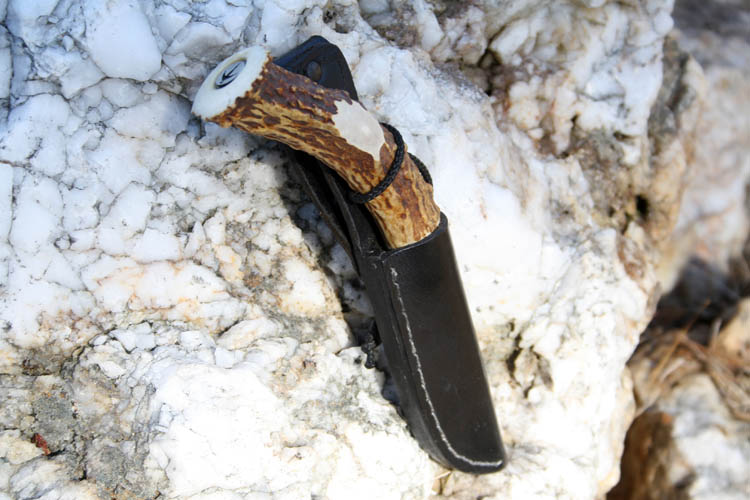
This will probably be my favorite hunting knife for the time
being, unless it is lost, misplaced or traded and/or sold......grin if you must!
I am looking forward to using this knife to
field dress deer this coming
fall, the Lord willing of course.
There have been many other knives used over the decades, of which I have
forgotten the brand names, etc., and/or don't have any
pixs of them. I have given numerous knives away to family and friends
and remember giving one of my classmates Ralph Coble of Wadesboro, NC a bone handle Case pocket knife as
a graduation present in 1963 and he still carries that pocket knife with him
today. It would be scary to know how many knives I have lost and
misplaced over the years too!
Web published by Bill aka Mickey Porter on 03-15-17; updated pixs on
03-16-17.
SAVAGE MADE SHEATHS
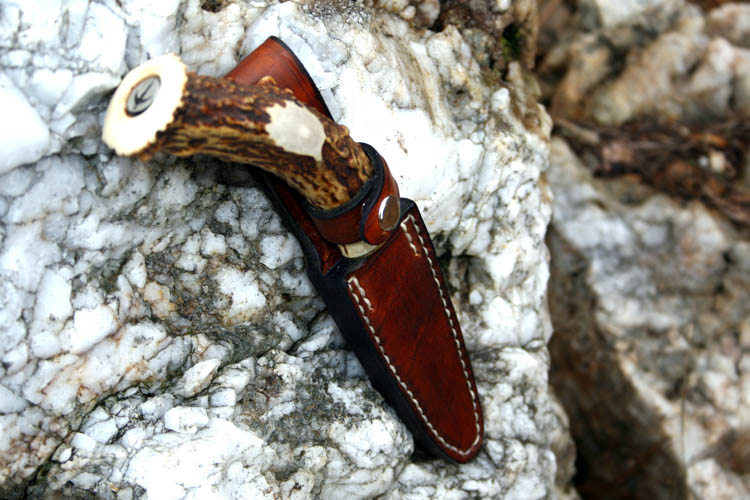
I had Harry Savage make me a Randall Style B sheath for my
custom knife.
Harry does outstanding leather sheath work and highly recommend his custom hand
made products. Click on the picture above for a hyperlink that will send
you to Harry's website.
I like the sheath Harry Savage made for me better than the converted Buck
sheath. Harry's custom made sheath has the knife fitting like a glove.
I ground a slight finger groove in the knife handle to allow the leather
strap to tightly fit the handle, whereas the knife will not come out of the
sheath until the safety strap is unsnapped.
Web page updated by Bill aka Mickey Porter on 01-19-19.
MOST RECENT KNIFE CONVERSION
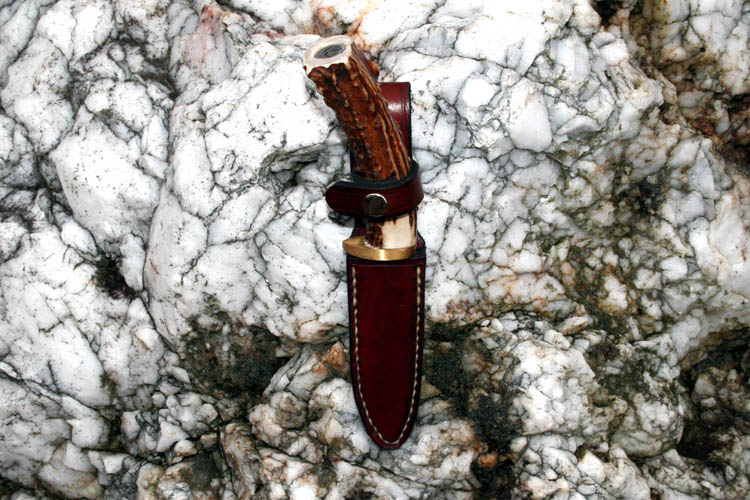
Back in January 2019, I did another
conversion of a Victorinox "Rabbit Knife"
adding a custom deer antler handle. I had Harry Savage of Saxis, VA
made the above custom sheath for the knife. The knife was gifted to
one of my friends Calvin Jones on 03-09-19, pix below:
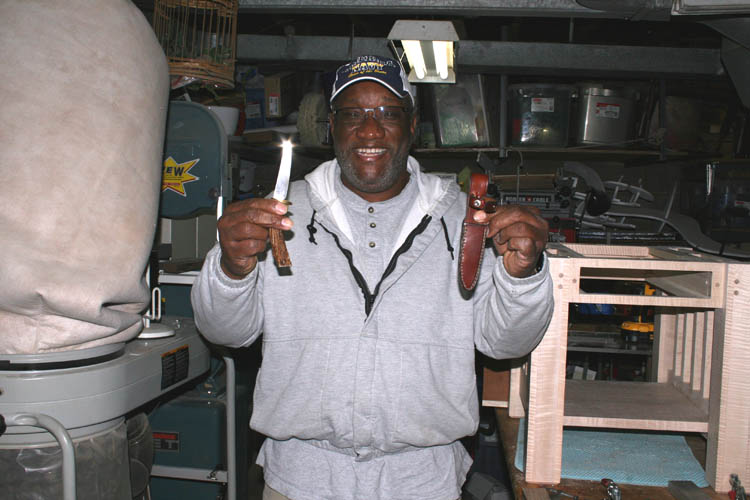
Web page updated by Bill aka Mickey Porter on 03-11-19.
CALVIN JONES KNIFE PIXS
Mr. C. aka Calvin Jones sent me several pixs of the knife gifted him and I
was impressed with them, therefore adding them to this page. I also
gave him the section that I removed from the deer antler knife handle to
shorten the length, of which will make a small paper weight or something.
I inlaid another turkey track medallion in the butt section of the deer
antler handle.
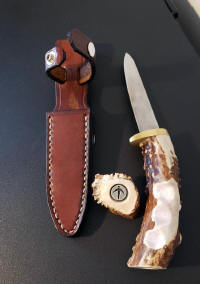
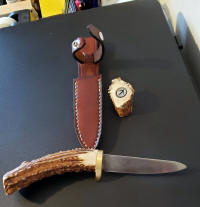
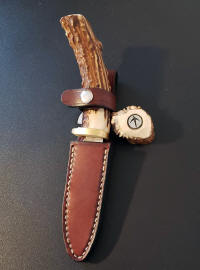
Web page updated by Bill aka Mickey Porter on 03-12-19.
ANOTHER KNIFE
I had one section of antler left from the 8 point buck harvest of 12-10-2018
and decided to make another field dressing and utility knife using a
Victorinox Kitchen Knife 6 inch stainless steel wide stiff blade.
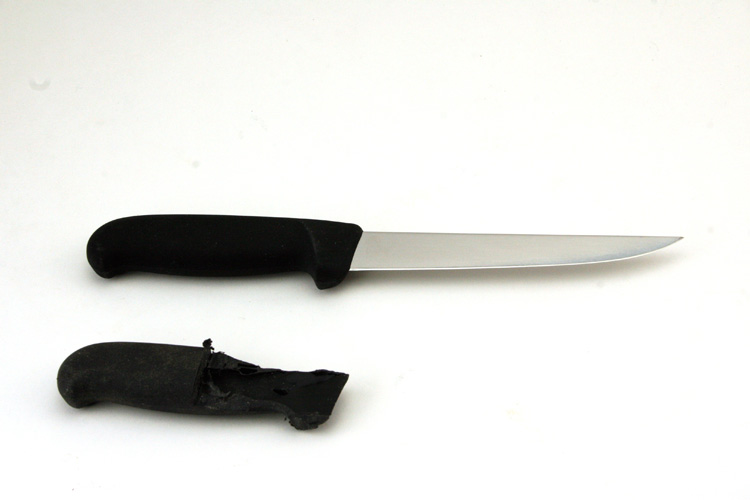
I did not take sequence pixs of the modification of the Victorinox knife
which basically the procedures were identical to the knife I made for Calvin
Jones annotated above.
I shortened the blade to 5 3/16 inch length for usage as a utility knife as
well. For field dressing deer, a blade length around 4 to 4.5 inches
is the ideal length in my humble opinion.
My 35MM DSLR camera body mirror definitely needs another cleaning
since there are dust spots showing in the above pix, especially on the upper
left hand portion of the pix. I will address that issue in the very
near future!
During the fabrication of the handle, I had some difficulty getting the
blade tang which had to be reground to about 3/8 inch in width to properly
align with the 3/8 inch hole I drilled in the antler. The hole was not
drilled "perfectly" for proper blade orientation, but made it work with some
"wallowing" out the antler drill cavity. I had to change the grind
angle on the handle that abutted the knife brass finger guard and it
shortened the length of the knife handle more than I like for my large hand,
but it will still work....not the best job I have done, but I didn't want to
discard the antler handle...........grin if you must!
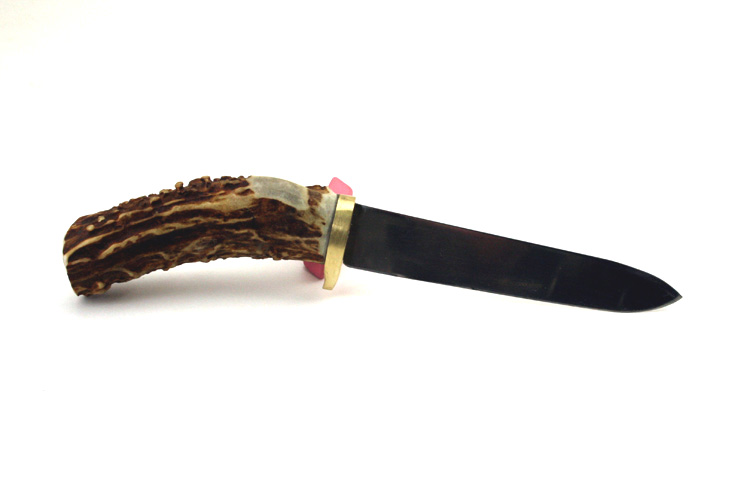
The tip of the knife resembles more of a spear point and/or drop point which
will work great for field dressing a deer, whereas the tip of the blade is
below the spine of the blade.
I am having Harry
Savage of Saxis, VA make a custom sheath for this knife and will
post a pix when the sheath arrives.
Web page updated by Bill aka Mickey Porter on 02-26-2021.
DIDN'T LIKE THE ANTLER HANDLE
I wasn't pleased with the above antler handle since it was too short for my
large hand. I had a shed antler that is at least 40 plus years old
that was found behind our
home on White Store Road and decided to use it.
It was just large enough to fit the finger guard on the above knife.
I band sawed slots into the handle the length of the recessed knife tang and
worked it loose with a chisel. The epoxy glue did a good job holding
the tang into the handle. I gave the handle portion left to our
Grandson Xander McKnight Gonzales, of which had a turkey track medallion
inlaid into it and also the rest of the shed antler that wasn't used.
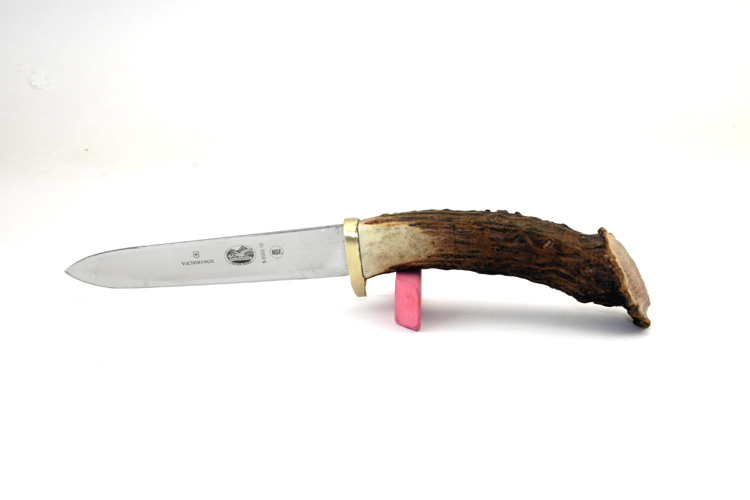
This antler crown handle fits my hand very well and has much more overall
eye appeal. I will give this knife a field test this coming hunting
season, our Lord willing of course.
Web page updated by Bill aka Mickey Porter on 03-03-2021.
KNIFE WITH HARRY SAVAGE CUSTOM SHEATH
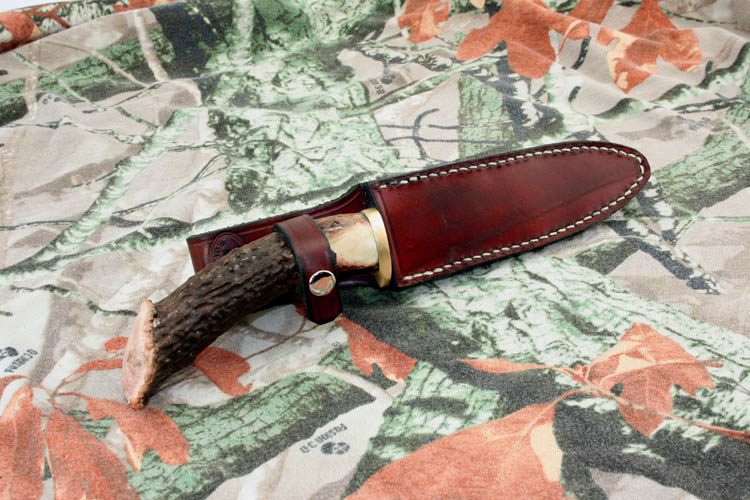
Looking forward to using this knife in the future, our Lord willing of
course.
INLAID INDIAN HEAD NICKEL
I inlaid a Indian Head Nickel in the antler crown handle. I couldn't
find the correct size bit to drill the cavity, but purchased a 7/8 inch
diameter Forstner drill bit that would work, however oversized.
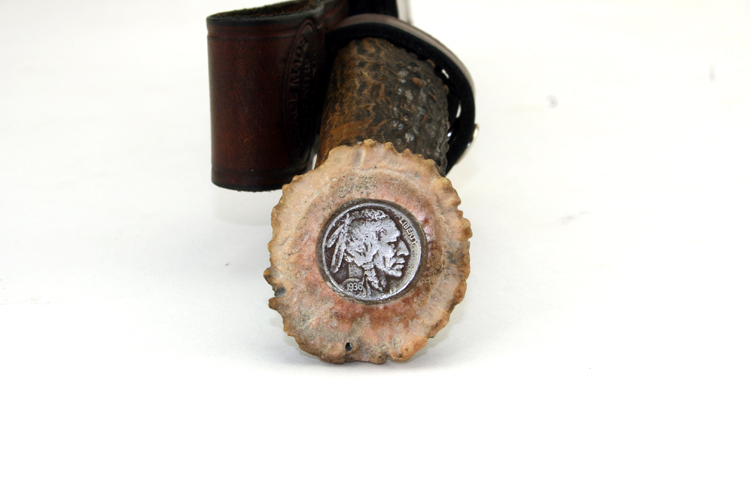
I had about forty (40) Indian Head Nickels and only half a dozen wasn't worn
too badly. The mint date on the Indian Head Nickel is 1936.
Our government certainly did the Native American Indians wrong and practiced
genocide via
manifest destiny and wiped out entire
cultures of them, yet "we" point the fingers at other countries for
committing the same type of
inhumane crimes!
I would not trust a Bureaucrat aka Stupacrat regardless of party affiliation and
their die hard supporters in an outhouse with a muzzle on.
Native Americans summed Washington and it's Bureaucrats up very well
during the period of their
systematic destruction during the second half of
the nineteenth century, "White man speak with forked tongue."
For a Native American History Lesson with controversial evidence and
documentation, read
Bury My Heart At Wounded Knee by Dee Brown which might open your
political blindness. It is estimated that between 80 to 100 million
native Americans have died since European settlers came to North and South
America by various diseases and outright genocide.
Looking forward to using this knife in the future, our Lord willing of
course.
Web page updated by Bill aka Mickey Porter on 03-05-2021 and 03-08-2021.
LEAVING ON A
SPIRITUAL NOTE
If you do not know Jesus Christ as your Lord and Savior, please take
this moment to accept him by Faith into your Life, whereby Salvation
will be attained.
Ephesians 2:8 - 2:9 8 For by grace are ye saved through
faith; and that not of yourselves: [it is] the gift of God: 9 Not of
works, lest any man should boast.
Hebrews 11:1 “Now faith is the substance of things hoped for,
the evidence of things not seen.”
Romans 10:17 “So then faith cometh by hearing, and hearing by
the word of God.”
Open this
link about faith in the King James
Bible.
Romans 10:9 “That if thou shalt confess with thy mouth the
Lord Jesus, and shalt believe in thine heart that God hath raised him
from the dead, thou shalt be saved.”
Open this
link of Bible Verses About Salvation,
King James Version Bible (KJV).
Hebrews 4:12 “For the word of God is quick, and powerful, and
sharper than any two edged sword, piercing even to the dividing asunder
of soul and spirit, and of the joints and marrow, and is a discerner of
the thoughts and intents of the heart.”
Romans 6:23 “For the wages of sin is death; but the gift of
God is eternal life through Jesus Christ our Lord.”
Romans 3:23 “For all have sinned, and come short of the glory
of God;”
Micah 6:8 “He hath shewed thee, O man, what is good; and what
doth the LORD require of thee, but to do justly, and to love mercy, and
to walk humbly with thy God?”
Philippians 4:13 "I can do all things through Christ which
strengtheneth me."


